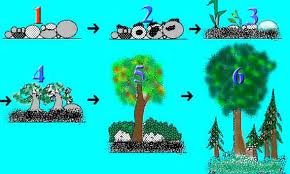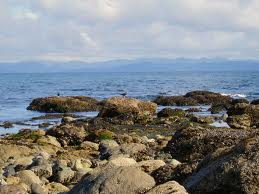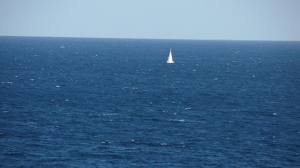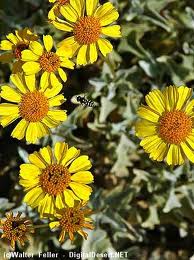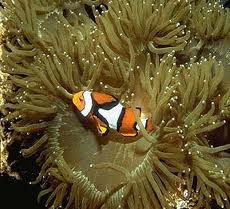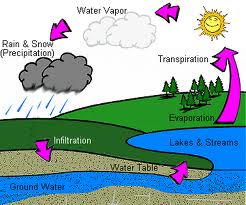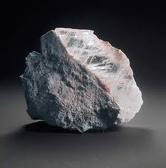Ecological succession, a fundamental concept in ecology, refers to moThe trajectory of ecological change can be influenced by site conditions, by the interactions of the species present, and by more stochastic factors such as availability of colonists or seeds, or weather conditions at the time of disturbancere or less predictable and orderly changes in the composition or structure of an ecologiccal community.
Pionner spieces:The first spieces livung in an area.You notice that the blooming of fireweed has attracted animals such as insects and an occasional insect-eating bird.
pioneer community:The first community living in an area.Its is the prout of a douglas fir tree.
climax community:It is the final stage of succession.This community will stay largely unchanged unless some major event occurs.
Science Class
Saturday, November 27, 2010
Summary about world biomes
World
Biomes:
land:
water:
fresh water: plankton:organism float in water.
nekton:organism that swim in the water
benthos:loottom-dweling organism
saltyv water: intertidal:0-100m depth
open ocean:upperer geon
bowerrsion
Biomes:
land:
- tropical rainforest
- decidious forest
- grassland
- taiga
- tundra
- desert
water:
fresh water: plankton:organism float in water.
nekton:organism that swim in the water
benthos:loottom-dweling organism
saltyv water: intertidal:0-100m depth
open ocean:upperer geon
bowerrsion
Monday, October 25, 2010
summary of surviving in ecosystem
Symbiosis:
Two organisms relate
together by helping or
harming each other.
type of simbiosis:
mutualism:
two organisms benefit each other.
parasitism:
One organism benefits and
the other harms.
Commensalism:
Two organisms that benefit
each other not harming but
protecting.
Two organisms relate
together by helping or
harming each other.
type of simbiosis:
mutualism:
two organisms benefit each other.
parasitism:
One organism benefits and
the other harms.
Commensalism:
Two organisms that benefit
each other not harming but
protecting.
summary
The continous movement of water between Earth´s surface and the air,changinh from liquid to gas to liquid.
The transfer of nitrogen fro the atmosphere to plants and back to theatmosphere and then directlto the plants again.
The continous transfer of carbon between the atmospherer and livings things.
Monday, October 18, 2010
Summary about food chains and food webs
Food chain is the path of energy in food from one organism to another.On the praire the first organisms in a food chain are plants. Plants capture the Sun's energy during photosynthesis.
Food web is the overlapping food chains in a community.Afood web shows how one population can be part of more than one food chain.
Summary about living things and their environment
An ecosystem is all the livings is an area interacting with each other.
Biotic: Abiotic:
examples: examples:
protist soil rocks
animals minerals
plants air
fungi water
bacteria light
biotic factor:
Abiotic factor:
biotic factor Any of the factors of an organism's environment that consist of other living organisms and together make up the biotic factor . These factors may affect an organism in many ways; for example, as competitors, predators, parasites, prey, or symbionts. In time, the distribution and abundance of the organism will be affected by its interrelationships with the biotic environment.
abiotic factor Deads animals,dead plants are example of abiotic factor.Basically anything not living is an example of abiotic factor.Abiotic Factor is all nonliving part of an ecosystem.
Ecosystem: abiotic factor Deads animals,dead plants are example of abiotic factor.Basically anything not living is an example of abiotic factor.Abiotic Factor is all nonliving part of an ecosystem.
Biotic: Abiotic:
examples: examples:
protist soil rocks
animals minerals
plants air
fungi water
bacteria light
biotic factor:
Abiotic factor:
Summary about Energy Source
Alternative
Energy
Source:
Wind Energy:
wind energy is a converted form of solar energy. The sun's radiation heats different parts of the earth at different rates-most notably during the day and night, but also when different surfaces (for example, water and land) absorb or reflect at different rates. This in turn causes portions of the atmosphere to warm differently. Hot air rises, reducing the atmospheric pressure at the earth's surface, and cooler air is drawn in to replace it.
Water Energy:
Water, like many substances, contains two kinds of energy. The first kind of energy is called kinetic energy. This is energy that is used during the execution of processes, such as movement. Because of kinetic energy water can flow and waves can exist.
But water can also contain potential energy. This is energy that is stored in the water. Stored, but not used. This energy can become useful when water starts to flow. It will be transferred to kinetic energy and this will cause movement.
Solar Energy:
Solar collectors collect solar radiation and transfer it as heat to a carrier fluid. It can then be used for heating. Solar energy is inexhaustible and nonpolluting, but converting solar radiation to electricity is not yet commercially competitive, because of the high cost of producing large-scale solar cell arrays and the inherent inefficiency in converting light to electricity.
Geothermal Energy:
Power obtained by using heat from the Earth's interior. Most geothermal resources are in regions of active volcanism. Hot springs, geysers, pools of boiling mud, and fumaroles are the most easily exploited sources.Thermal energy contained in the earth; can be used directly to supply heat or can be converted to mechanical or electrical energy.
pictures:
Energy
Source:
- Wind Energy
- Water Energy
- Solar Energy
- Geothermal Energy
Wind Energy:
wind energy is a converted form of solar energy. The sun's radiation heats different parts of the earth at different rates-most notably during the day and night, but also when different surfaces (for example, water and land) absorb or reflect at different rates. This in turn causes portions of the atmosphere to warm differently. Hot air rises, reducing the atmospheric pressure at the earth's surface, and cooler air is drawn in to replace it.
Water Energy:
Water, like many substances, contains two kinds of energy. The first kind of energy is called kinetic energy. This is energy that is used during the execution of processes, such as movement. Because of kinetic energy water can flow and waves can exist.
But water can also contain potential energy. This is energy that is stored in the water. Stored, but not used. This energy can become useful when water starts to flow. It will be transferred to kinetic energy and this will cause movement.
Solar Energy:
Solar collectors collect solar radiation and transfer it as heat to a carrier fluid. It can then be used for heating. Solar energy is inexhaustible and nonpolluting, but converting solar radiation to electricity is not yet commercially competitive, because of the high cost of producing large-scale solar cell arrays and the inherent inefficiency in converting light to electricity.
Geothermal Energy:
Power obtained by using heat from the Earth's interior. Most geothermal resources are in regions of active volcanism. Hot springs, geysers, pools of boiling mud, and fumaroles are the most easily exploited sources.Thermal energy contained in the earth; can be used directly to supply heat or can be converted to mechanical or electrical energy.
pictures:
Subscribe to:
Posts (Atom)

